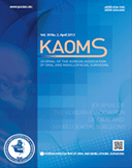Journal of the Korean Association of Oral and Maxillofacial Surgeons
- P-ISSN2234-7550
- E-ISSN2234-5930
- SCOPUS, KCI, ESCI
 ISSN : 2234-7550
ISSN : 2234-7550
A two-year audit of non-vascularized iliac crest bone graft for mandibular reconstruction: technique, experience and challenges
Akinwale Efunkoya (Aminu Kano Teaching Hospital, Kano, Nigeria)
Ibiyinka Amole (Aminu Kano Teaching Hospital, Kano, Nigeria)
Benjamin Akhiwu (Aminu Kano Teaching Hospital, Kano, Nigeria)
Daniel Osunde (Aminu Kano Teaching Hospital, Kano, Nigeria)
Abstract
Objectives: Non-vascularized iliac crest bone graft (NVIBG) is a known treatment option in mandibular reconstruction following jaw resection, but no documented review of patients treated with NVIBG exists for northern Nigeria. The experience and technique from a Nigerian tertiary hospital may serve as baseline data for comparison and improvement of practice for other institutions.Materials and Methods: A retrospective review of medical records and patient case filesfrom January 2012 to December 2013 was undertaken. All case filesand other medical records of patients who had reconstruction with NVIBG for benign or malignant lesions with immediate or delayed recon-struction were selected for review.Results: Twenty patients had mandibular reconstruction with NVIBG during the study period. Two patients were excluded because of incomplete medical records. Eighteen patients’ (male=14, female=4) records were reviewed. Their ages ranged from 13 to 62 years (mean 26.0±10.6 years). Indi-cations for NVIBG included jaw tumors (n=16; 88.3%), jaw cyst (n=1; 5.6%) and gunshot injury (n=1; 5.6%). Jaw tumors seen were ameloblastoma (n=15; 83.3%) and osteosarcoma (n=1; 5.6%). Treatments done were mandibular resection with condylar resection (n=7; 38.9%), mandibular segmen-tal resection (n=10; 55.6%) and subtotal mandibulectomy (n=1; 5.6%). Patients’ postoperative reviews and radiographs revealed good facial profie and continued bone stability up to 1 year following NVIBG.Conclusion: NVIBGs provide an acceptable alternative to vascularized bone grafts, genetically engineered bone, and distraction osteogenesis for mandibular reconstruction in resource-limited centers.
- keywords
- Mandibular resection, Mandibular reconstruction, Non-vascularized iliac crest bone graft
- 다운로드 수
- 조회수
- 0KCI 피인용수
- 0WOS 피인용수